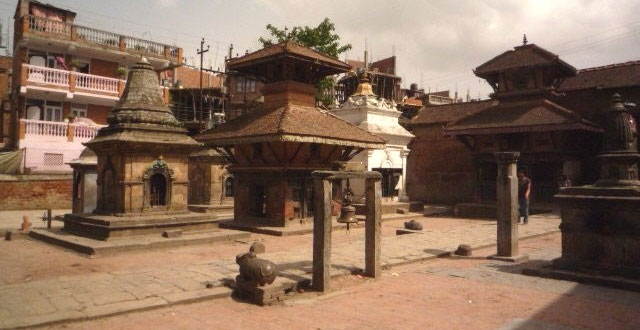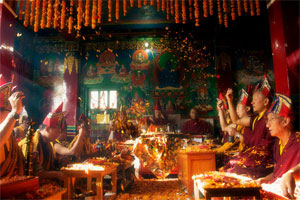
The name Kirtipur comes from Kirti (Glory) and pur (city). It is also said that once a queen named 'Kirti' ruled over this place so, it might have been named after same queen since 'pur' means city, and it states Kirtipur means city of 'Kirti'.
Originally a Newari foundation, Kirtipur is still a centre of Newari culture. It has been merged with surrounding villages to form the municipality of Kirtipur with a population of around 50,000. It consists of many temples, Gumbas(Buddhist monastery) and Churches too. Due to the presence of Tribhuvan University, Kirtipur is also popular area for out-of-town students and professors to rent houses and they are major contributors to the local economy. Relationship between the locals and the non-locals is generally harmonious.

In 1826 B.S. (Bikram Sambat) it was annexed to the Gorkhali kingdom of Nepal by King Prithvi Narayan Shah on his third attempt, after bribing the doorman of the city. After he did this, to spite the city of Kirtipur, he cut off the noses of all the men in the city.
This was the site of an inspirational peaceful demonstration of the people in the 2006 mass uprising that overthrew the powers of the king. It is considered to be an anti-monarchy city due to its bitter history against the Shah dynasty whose modern founder conquered the city insultingly, which was followed by negligence of the administration and development by subsequent rulers
Dakshinkali Temple
 At the southern edge of the valley, Dakshinkali Temple or Dakshin Kali Temple located 22 kilometres, At the southern edge of the valley, in a dark, somewhat spooky location in the cleft between two hills and at the confluence of two rivers stands the blood-soaked temple of Dakshinkali. The temple is dedicated to the goddess Kali, Shiva's consort in her most bloodthirsty incarnation, and twice a week faithful Nepal’s journey here to satisfy her bloodlust.
At the southern edge of the valley, Dakshinkali Temple or Dakshin Kali Temple located 22 kilometres, At the southern edge of the valley, in a dark, somewhat spooky location in the cleft between two hills and at the confluence of two rivers stands the blood-soaked temple of Dakshinkali. The temple is dedicated to the goddess Kali, Shiva's consort in her most bloodthirsty incarnation, and twice a week faithful Nepal’s journey here to satisfy her bloodlust.
Sacrifices are always made to goddesses, and the creatures to be sacrificed must be uncastrated male animals. Saturday is the major sacrificial day of the week, when a steady parade of chickens, ducks, goats, sheep, pigs and even the occasional buffalo come here to have their throats cut or their heads lopped off by professional local butchers. Tuesday is also a sacrificial day, but the blood does not flow quite as freely. During the annual celebrations of Dasain in October the temple is literally awash with blood and the image of Kali is bathed in i
Pharping
 Pharping, a town south of Kathmandu in Nepal, It is a thriving, traditional Newari town, 19km south of Kathmandu and surprisingly untouched by the swarms of tourists that visit Dakshinkali. The town is famous for its pilgrimage sites, the Hindu origins of which have been largely absorbed by the now predominant Tibetan Buddhist monasteries. The town is popular with both Tibetan and Hindu pilgrims.
Pharping, a town south of Kathmandu in Nepal, It is a thriving, traditional Newari town, 19km south of Kathmandu and surprisingly untouched by the swarms of tourists that visit Dakshinkali. The town is famous for its pilgrimage sites, the Hindu origins of which have been largely absorbed by the now predominant Tibetan Buddhist monasteries. The town is popular with both Tibetan and Hindu pilgrims.
It is identified with the sacred site of Yangleshö (Wyl. yang le shod), where Guru Padmasambhava attained the level of a Mahamudra vidyadhara. Yangleshö is thus, according to Katok Rigdzin Tsewang Norbu, considered to be for Vajrayana practitioners as important as Bodhgaya because it is where the second buddha Guru Padmasambhava attained the state of enlightenment.
There are two major practice caves in Pharping blessed by Guru Rinpoche: the Asura cave and the Yangleshö cave. At the bottom of the flight of stairs climbing up to the Asura cave is an old and important Vajrayogini temple, the Pharping Vajravarahi temple. Other stairs also lead up to the cave. They start towards the end of the village, at Ralo Rinpoche's monastery and start by a shrine containing a self-arisen Tara on the side of an image of Ganesha. To the south of the village is the temple of Dakshinkali, one of the four Kalis surrounding the Kathmandu valley. Pharping also has several monasteries, temples and retreat centres, including Chatral Rinpoche's monastery, and the Palyul Retreat Centre, which is the residence of Khenpo Namdrol Rinpoche and home to the Rigpa Shedra.
 Pharping is known to the Tibetans as Yanglseshö, and to the Nepali as Pharping (pronouce "farping"). It was also known as Phamting. Some say it is because it is the birthplace of the Phamtingpa, the heart-son of Naropa, and his brothers.[1] Chatral Rinpoche explains that the 'Indian Phamting' (rgya gar pham thing) derives its name from the presence of the great hood of the naga king Lhakmachen or Shesha which indicate that it is a place associated with him. That is why the place the learned masters of the past used to called it Phanathingu (pha na thinggu), which means 'the nine hoods', and the usage ebbed as Phamting.
Pharping is known to the Tibetans as Yanglseshö, and to the Nepali as Pharping (pronouce "farping"). It was also known as Phamting. Some say it is because it is the birthplace of the Phamtingpa, the heart-son of Naropa, and his brothers.[1] Chatral Rinpoche explains that the 'Indian Phamting' (rgya gar pham thing) derives its name from the presence of the great hood of the naga king Lhakmachen or Shesha which indicate that it is a place associated with him. That is why the place the learned masters of the past used to called it Phanathingu (pha na thinggu), which means 'the nine hoods', and the usage ebbed as Phamting.
Pharping has not only been blessed by the master of Oddiyana's practice with his consort Shakyadevi and his attainment of the vidyadhara level of Mahamudra, it has been also visited by many great beings, like long term resident Marpa Lotsawa, who practised, made offerings, ganachakra feasts, aspiration prayers and so on.